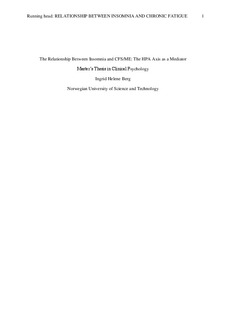| dc.contributor.advisor | Stiles, Tore | nb_NO |
| dc.contributor.author | Berg, Ingrid Helene | nb_NO |
| dc.date.accessioned | 2014-12-19T14:43:16Z | |
| dc.date.available | 2014-12-19T14:43:16Z | |
| dc.date.created | 2014-07-10 | nb_NO |
| dc.date.issued | 2013 | nb_NO |
| dc.identifier | 733565 | nb_NO |
| dc.identifier.uri | http://hdl.handle.net/11250/271206 | |
| dc.description.abstract | Fatigue is common in the general population, and is the hallmark of chronic fatigue syndrome/myalgic encephalomyelitis (CFS/ME). Although the occurrence of sleep difficulties is known to be common in subjects with fatigue, research on insomnia in such subjects is absent. The current study sought to examine the impact comorbid insomnia has on level of fatigue in subjects with chronic fatigue. The aim of this study is to assess the relationship between insomnia and chronic fatigue, and examine if the relationship is affected by the endocrine activity in the HPA axis. The following hypotheses were tested: 1) Do patients with chronic fatigue and comorbid insomnia experience more fatigue than patients with chronic fatigue without comorbid insomnia? 2) Do patients with chronic fatigue and with initially comorbid insomnia experience more fatigue after treatment than chronic fatigue patients without comorbid insomnia? 3) Do patients with chronic fatigue who experience improvement in insomnia after treatment also experience less fatigue by the end of treatment compared with patients who do not experience improvement in insomnia? 4) Is the potential relationship between insomnia and chronic fatigue influenced by the activity of the HPA axis as expressed by variation in cortisol output measured by Trier Social Stress Test for Groups (TSST-G)? The study sample consisted of 75 patients with chronic fatigue. Thirty-three met criteria for insomnia, while 42 did not. While staying at Hysnes Rehabilitation Center in Trondheim, Norway, they received a work-related Acceptance and Commitment Therapy (ACT) treatment intervention lasting 3.5 weeks. In addition, they participated in a standardized stress test (Trier Social Stress Test) pre- and post-treatment. Saliva cortisol samples were collected during the test in order to measure variation in cortisol output. The current finding is the first description of how insomnia in patients with chronic fatigue is associated with higher levels of fatigue (p < .05). Further, this study gives preliminary support indicating that remission of insomnia in patients with chronic fatigue can significantly reduce levels of fatigue (p < .05), and furthermore improve the physiological stress-response (p < .05). These results might encourage clinicians to assess and provide specific treatment for insomnia in patients with chronic fatigue as this might improve their treatment results. An aim for further research should be to investigate the effect of specified treatment for insomnia in patients with chronic fatigue. | nb_NO |
| dc.language | eng | nb_NO |
| dc.publisher | Norges teknisk-naturvitenskapelige universitet, Fakultet for samfunnsvitenskap og teknologiledelse, Psykologisk institutt | nb_NO |
| dc.subject | insomnia | en_GB |
| dc.subject | chronic fatigue | en_GB |
| dc.subject | hypothalamic–pituitary–adrenal (HPA) axis | en_GB |
| dc.subject | salivary cortisol | en_GB |
| dc.subject | Trier Social Stress Test for Groups | en_GB |
| dc.subject | Acceptance and Commitment Therapy | en_GB |
| dc.title | The Relationship Between Insomnia and CFS/ME: The HPA Axis as a Mediator | nb_NO |
| dc.type | Master thesis | nb_NO |
| dc.source.pagenumber | 34 | nb_NO |
| dc.contributor.department | Norges teknisk-naturvitenskapelige universitet, Fakultet for samfunnsvitenskap og teknologiledelse, Psykologisk institutt | nb_NO |
